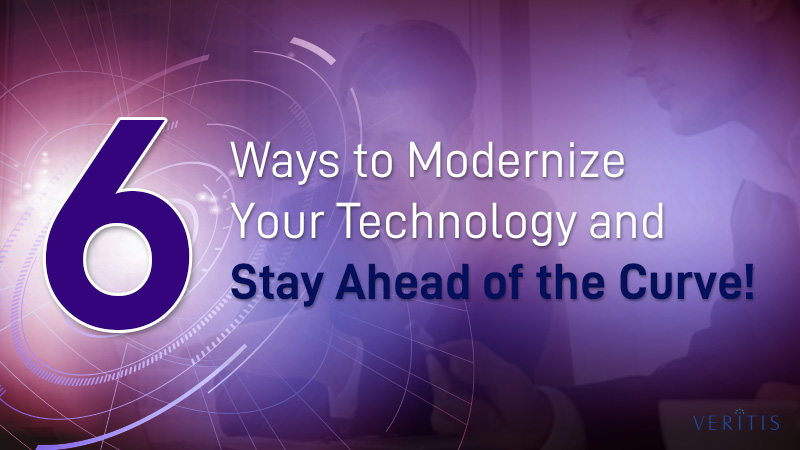
Organizations are constantly faced with a common question, ‘How do we stand out from the rest’?
Stiff competition constantly keeps organizations on their toes to improve service delivery and retain the existing customer base while trying to draw more.
This is definitely not possible with a stagnant approach characterized by the usage of legacy systems, outdated technology and traditional IT practices.
That’s why organizations need to familiarize themselves with ways to modernize their existing technology.
Here’s how they can:
1) Customer First

Organizational success and life span thrive on customer satisfaction and customer value. The first step to staying in competition is putting the customer first. When planning an IT modernization roadmap, it is essential to create a strong ‘business case’. The business case should cover clearly-defined outcomes and how each aspect of the upgraded IT infrastructure will contribute to each outcome including customer retention, user experience, sales, productivity and recruiting.
The next step is collaborating diverse teams to chalk out the modernization path. This includes teams such as IT, strategic business development, customer interaction and operations that collaborate in an agile environment to design architecture in line with common specifications. This stage brings together strategic insight with agile technology to produce a common goal, within a common reference point.
Recipe for a strong business case:
- Why do we need to upgrade our technology now?
- What problems do we want to solve?
- How will this change deliver value to our customers?
2) Simple Architecture

IT infrastructure is key to any organization but most of our architecture is haphazard and designed to serve the current need. This usually results in complex technologies, which serve individual applications but cannot evolve or be integrated with each other.
However, the new set of platforms have changed this scenario. The standardization of software code and integration standards have enabled applications and systems to interact fully. Tools including APIs and CRMs help organizations develop interoperable components to interact seamlessly and share data across the length and breadth of the organization through a common platform.
3) Built for Flexibility and Speed

The complexities of the past systems limited their ability to evolve and integrate as per an organization’s growth needs. When organizations needed to scale their operations to more areas of focus, these systems failed to provide them with flexibility. Modern day systems provide these capabilities by accommodating a range of plug-and-play functions for businesses.
The flexibility to design and restructure these new era systems help organizations innovate and add value to business processes, and ultimately end-user experience.
Organizations should use the ‘Minimum Viable Product’ (MVP) approach to assess the fitness of new IT systems or upgrades. This approach consists of a basic-level installation including certain features that are vital to estimate the system’s value. The next step is to introduce this system to your employees and a sample group of customers.
This helps you understand customer preferences in terms of usability and functionality and alter your technology accordingly, thus enabling the required flexibility and the speed for service-delivery.
4) With Service as the Center of Focus

While the traditional approach viewed systems as assets, modern day approach treats them as a set of services that a company can channel and integrate to serve its needs (not necessarily owning them). Firms can select and combine them from the best of providers such as Amazon, Microsoft, Google and more, within their infrastructure framework to suit special business needs.
The key here is, when a company collaborates with a provider to host its offerings, it should look beyond the hardware and software aspects, and focus on services benefiting internal functions. These internal functions will ultimately impact customer service delivery.
With services mind-set, organizations can establish a value-driven relationship with service providers. Also, by considering providers as ongoing partners in innovation, firms can shift their focus from negotiating terms to jointly generating results with web service providers.
5) Agile and User-Focused

When considering modernization, organizations must aim to avail benefits ‘faster.’ Avoid the approach that aims to deliver an ‘all-in-one systems’ release. Instead, divide the modernization process into a user-oriented approach by introducing usable functions on a frequent basis.
It is always better to deliver step-by-step and rapidly, than releasing service offerings all at once and with long intervals. And not to forget that stakeholder (including customers, employees and all entities connected) feedback is crucial in this process. The usage of user-feedback driven frameworks helps organizations to achieve agility while remaining committed to the end-user experience.
6) Resources Driven for change

While working to bring in the desired technological transformation, it is essential to consider your organization’s resources and how best you can utilize them. You can begin with, human resources encompassing strong project management and leadership followed by financial resources to direct funds only to important areas, especially scrutinizing investments for upgrading legacy systems.
Furthermore, it is important to be selective about external resources such as vendors. It is always best to distribute your data and systems among multiple vendors, rather than staying vendor locked-in. The usage of open APIs that connect to multiple other systems is also important.
Adapt to the usage of open source software and make interoperability and integration a critical part of your technology.
Technology Transformation with the Right IT Advisory
But how will you go about this major technological transformation without the right insight and guidance for the transition from legacy to new?

Technology advisory services play a key role in helping organizations bring in the much needed technological transformation and ensure the right impact on service delivery. Now that you know what to bring about technology transformation, Veritis can enhance this experience by providing you with the right insight at every step of the process!
Organizations have to develop ‘a step-ahead approach’ by investing in and employing parameters that drive technological transformation.
Are you looking to innovate? Then it’s time for a technological transformation!
